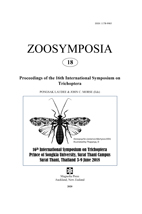Abstract
In order to estimate mating frequencies of females, spermatophores stored in the bursa copulatrix were examined in three Asian species of the genus Lepidostoma Rambur (Lepidostomatidae): L. complicatum (Kobayashi 1968), L. satoi (Kobayashi 1968), and L. itoae (Kumanski & Weaver 1992), during their flight seasons of 2011 to 2016. In all three species, several spermatophores were detected, particularly in late seasons, suggesting that multiple mating occurs in these caddisflies.
References
Arnqvist, G. & Nilsson, T. (2000) The evolution of polyandry: multiple mating and female fitness in insects. Animal Behaviour, 60, 145–164.
https://doi.org/10.1006/anbe.2000.1446
Gower, A.M. (1967) A study of Limnephilus lunatus Curtis (Trichoptera: Limnephilidae) with references to its life cycle in watercress beds. Transactions of the Royal Entomological Society of London, 119, 283–302.
https://doi.org/10.1111/j.1365-2311.1967.tb00501.x
Ito, T. (1983) Longitudinal distribution and annual life cycle of the japonicus group of Goerodes (Trichoptera, Lepidostomatidae). The Japanese Journal of Limnology, 44, 269–276.
https://doi.org/10.3739/rikusui.44.269
Ito, T. (2016) Protogyny in Lepidostoma Ramber, 1842 (Trichoptera: Lepidostomatidae), with delayed egg maturation. The Pan-Pacific Entomologist, 92, 1–8.
https://doi.org/10.3956/2016-92.1.1
Ito, T. & Yamamoto, E. (2012) First record of Lepidostoma itoae (Kumanski and Weaver) (Trichoptera, Lepidostomatidae) from Japan, with descriptions and ecological notes. Biology of Inland Waters, 27, 7–13.
Kobayashi, M. (1968) Notes on the caddisflies of Niigata Prefecture, with seven [sic] new species. Bulletin of the Kanagawa prefectural Museum (Natural Science), 1 (1), 1–12, Pl. I–VI.
Khalifa, A. (1949) Spermatophore production in Trichoptera and some other insects. Transactions of the Royal Entomological Society of London, 100, 449–479.
https://doi.org/10.1111/j.1365-2311.1949.tb01425.x
Kiss, O. (2012) Trichoptera collected by light trapping from the Hungarian section of the River Tisza. Braueria, 39, 25–31.
Kumanski, K. & Weaver, J.S.III (1992) Studies on the fauna of Trichoptera (Insecta) of Korea IV. The family Lepidostomatidae. Aquatic Insects, 14, 153–168.
https://doi.org/10.1080/01650429209361478
Matsumoto, K. & Eguchi, M. (1990) Female mating frequency in the caddisfly, Perissoneura paradoxa McLachlan, estimated by the spermatophore counts. Japanese Journal of Entomology, 58, 670–672. [in Japanese with English abstract]
Novák, K. & Sehnal, F. (1963) The development cycle of some species of the genus Limnephilus (Trichoptera). Casopis Československe Spoleĉnosti Entomologické, 60, 68–80.
Nowinszky, L., Puskaìs, J. & Kiss, O. (2016) Protandry and protogyny in swarmings of caddisflies (Trichoptera) species in Hungary (central Europe). International Journal of Research in Zoology, 6, 1–5.
Nozaki, T. & Gyotoku, N. (1990) Seasonal change of caddisflies (Trichoptera; Insecta) from daily light trap collections on Chikushino City, northern Kyushu, Japan. Biology of Inland Waters, 5, 10–17. [in Japanese with English abstract]
Petersson, E. (1991) Effects of remating on the fecundity and fertility of female caddis flies, Mystacides azurea. Animal Behaviour, 41, 813–818.
https://doi.org/10.1016/S0003-3472(05)80348-3
Simmons, L.W. (2001) Sperm Competition and Its Evolutionary Consequences in the Insects. Princeton University Press, New Jersey, 456 pp.
https://doi.org/10.1515/9780691207032
Svensson, B.W. (1972) Flight periods, ovarian maturation, and mating in Trichoptera at a South Swedish streams. Oikos, 23, 370–383.
https://doi.org/10.2307/3543177
Terra, L.S.W. (1978) First results of Trichoptera collected with light traps at Villa do Conde (Portugal). In: Crichton, M.I. (Ed.), Proceedings of the 2nd International Symposium on Trichoptera. Dr. W. Junk, The Hague, pp. 75–82.
https://doi.org/10.1007/978-94-017-2778-5_6
Usseglio-Polatera, P. (1987) The comparison of light trap and sticky trap catches of adult Trichoptera (Lyon, France). In: Bournaud, M. & Tachet, H. (Eds.), Proceedings of the 5th International Symposium on Trichoptera. Dr. W. Junk, Dordrecht, pp. 217–222.

